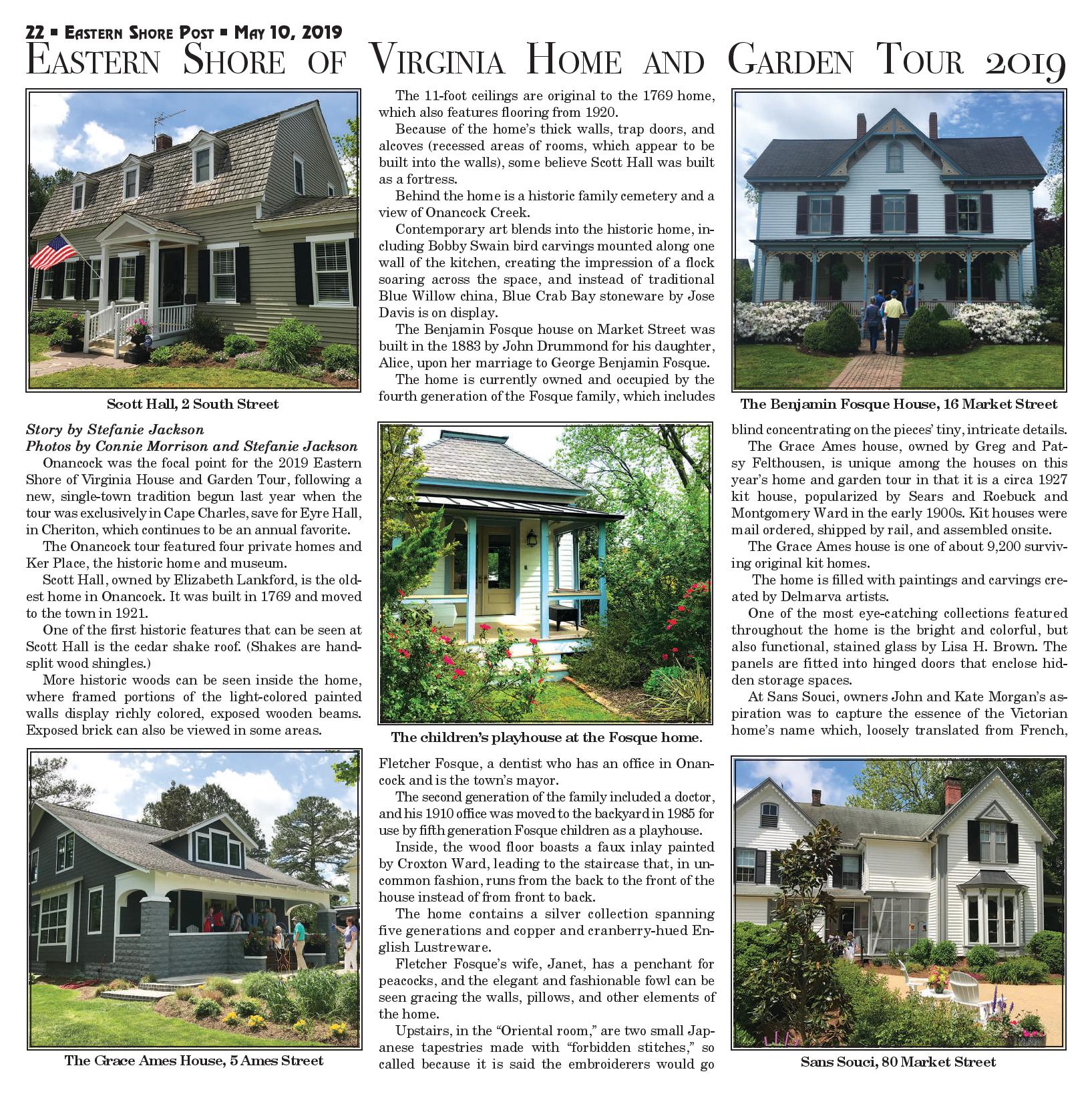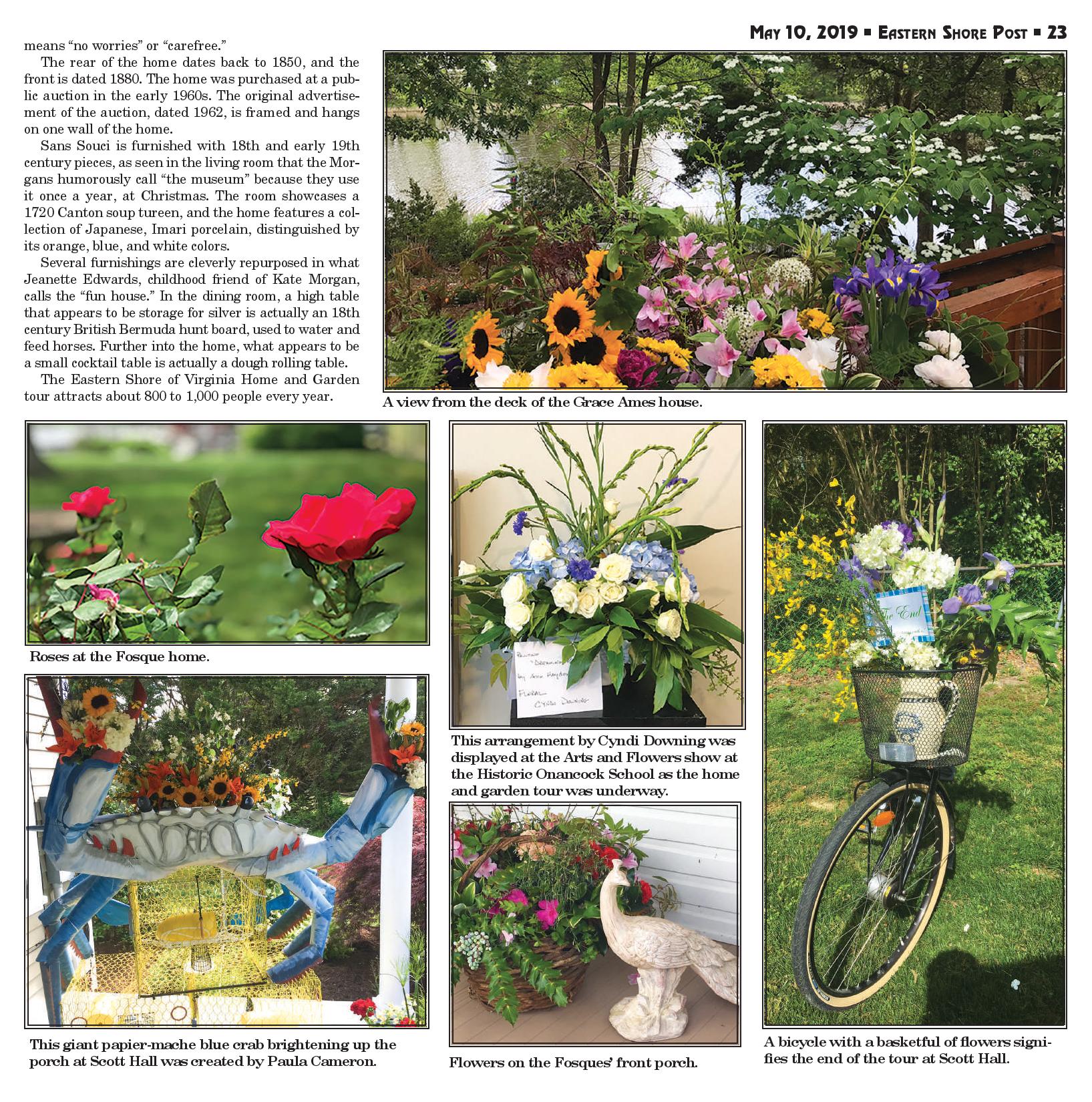Story by Stefanie Jackson (Photos by Connie Morrison and Stefanie Jackson) Onancock was the focal point for the 2019 Eastern Shore of Virginia House and Garden Tour, following a new, single-town tradition begun last year when the tour was exclusively in Cape Charles, save for Eyre Hall, in Cheriton, which continues to be an annual favorite.
The Onancock tour featured four private homes and Ker Place, the historic home and museum.
Scott Hall, owned by Elizabeth Lankford, is the oldest home in Onancock. It was built in 1769 and moved to the town in 1921.
One of the first historic features that can be seen at Scott Hall is the cedar shake roof. (Shakes are hand-split wood shingles.)
More historic woods can be seen inside the home, where framed portions of the light-colored painted walls display richly colored, exposed wooden beams. Exposed brick can also be viewed in some areas.
The 11-foot ceilings are original to the 1769 home, which also features flooring from 1920.
Because of the home’s thick walls, trap doors, and alcoves (recessed areas of rooms, which appear to be built into the walls), some believe Scott Hall was built as a fortress.
Behind the home is a historic family cemetery and a view of Onancock Creek.
Contemporary art blends into the historic home, including Bobby Swain bird carvings mounted along one wall of the kitchen, creating the impression of a flock soaring across the space, and instead of traditional Blue Willow china, Blue Crab Bay stoneware by Jose Davis is on display.
The Benjamin Fosque house on Market Street was built in the 1883 by John Drummond for his daughter, Alice, upon her marriage to George Benjamin Fosque.
The home is currently owned and occupied by the fourth generation of the Fosque family, which includes Fletcher Fosque, a dentist who has an office in Onancock and is the town’s mayor.
The second generation of the family included a doctor, and his 1910 office was moved to the backyard in 1985 for use by fifth generation Fosque children as a playhouse.
Inside, the wood floor boasts a faux inlay painted by Croxton Ward, leading to the staircase that, in uncommon fashion, runs from the back to the front of the house instead of from front to back.
The home contains a silver collection spanning five generations and copper and cranberry-hued English Lustreware.
Fletcher Fosque’s wife, Janet, has a penchant for peacocks, and the elegant and fashionable fowl can be seen gracing the walls, pillows, and other elements of the home.
Upstairs, in the “Oriental room,” are two small Japanese tapestries made with “forbidden stitches,” so called because it is said the embroiderers would go blind concentrating on the pieces’ tiny, intricate details.
The Grace Ames house, owned by Greg and Patsy Felthousen, is unique among the houses on this year’s home and garden tour in that it is a circa 1927 kit house, popularized by Sears and Roebuck and
Montgomery Ward in the early 1900s. Kit houses were mail ordered, shipped by rail, and assembled onsite.
The Grace Ames house is one of about 9,200 surviving original kit homes.
The home is filled with paintings and carvings created by Delmarva artists.
One of the most eye-catching collections featured throughout the home is the bright and colorful, but also functional, stained glass by Lisa H. Brown. The panels are fitted into hinged doors that enclose hidden storage spaces.
At Sans Souci, owners John and Kate Morgan’s aspiration was to capture the essence of the Victorian home’s name which, loosely translated from French, means “no worries” or “carefree.”
The rear of the home dates back to 1850, and the front is dated 1880. The home was purchased at a public auction in the early 1960s. The original advertisement of the auction, dated 1962, is framed and hangs on one wall of the home.
Sans Souci is furnished with 18th and early 19th century pieces, as seen in the living room that the Morgans humorously call “the museum” because they use it once a year, at Christmas. The room showcases a 1720 Canton soup tureen, and the home features a collection of Japanese, Imari porcelain, distinguished by its orange, blue, and white colors.
Several furnishings are cleverly repurposed in what Jeanette Edwards, childhood friend of Kate Morgan, calls the “fun house.” In the dining room, a high table that appears to be storage for silver is actually an 18th century British Bermuda hunt board, used to water and feed horses. Further into the home, what appears to be a small cocktail table is actually a dough rolling table.
The Eastern Shore of Virginia Home and Garden tour attracts about 800 to 1,000 people every year.





